The Cook's Illustrated Cookbook (299 page)
Read The Cook's Illustrated Cookbook Online
Authors: The Editors at America's Test Kitchen
Tags: #Cooking

![]() WHY THIS RECIPE WORKS
WHY THIS RECIPE WORKS
Bakers tend to argue over the authenticity of their madeleines, each one thinking that his or hers is the exact re-creation of the cookie that famously stirred Proust’s imagination. What everyone does agree on is that madeleines are small, feather-light, spongy cakes meant to be eaten like cookies. They are baked in a special pan with scallop shell indentations. Shortly after we began our search for the perfect madeleine, we gave up on history in favor of taste, texture, and simplicity. What we wanted was a cake-cookie that tasted lightly buttery and eggy, with a hint of vanilla; it also had to barely weigh down the tongue, and it had to be as simple as possible to prepare. We kept baking up batches of dry, dense madeleines until we started thinking about these cookies like mini cakes. Just as we do with some of our cakes, we used cake flour for the lightest crumb. And we added an egg yolk and extra butter to keep them moist. Lastly, we added a whopping tablespoon of vanilla extract for flavor.
MAKES 24 COOKIES
This recipe uses a 12-cookie madeleine mold; even if you have two molds, be sure to bake them one at a time.
1 | cup (4 ounces) cake flour |
¹⁄ | teaspoon salt |
2 | large eggs plus 1 large yolk |
¹⁄ | cup (3¹⁄ |
1 | tablespoon vanilla extract |
10 | tablespoons unsalted butter, melted and cooled |
1.
Adjust oven rack to middle position and heat oven to 375 degrees. Grease 12-cookie madeleine mold. Whisk flour and salt together in small bowl.
2.
Using stand mixer, beat eggs and egg yolk together on medium-high speed until frothy, 3 to 5 minutes. Beat in sugar and vanilla until very thick, 3 to 5 minutes. With rubber spatula, gently fold in flour mixture, followed by melted butter.
3.
Spoon half of batter into prepared mold, filling mold to rim. Bake until cookies are golden and spring back when pressed lightly, about 10 minutes, rotating madeleine mold halfway through baking.
4.
Let cookies cool in mold for 10 minutes, then flip out onto wire rack and let cool completely before serving, about 1 hour. Cool and re-grease mold and repeat with remaining batter.
Add 1 tablespoon grated fresh lemon zest or orange zest with sugar and vanilla.
Substitute ¹⁄
4
cup sifted Dutch-processed cocoa for ¹⁄
4
cup flour and add 2 teaspoons instant espresso powder to flour mixture.
Substitute 2 teaspoons rose water for vanilla extract.
Reduce vanilla to 2 teaspoons and add 1 teaspoon almond extract.
![]() WHY THIS RECIPE WORKS
WHY THIS RECIPE WORKS
These delicate cookies are known to be difficult in one crucial respect: they tend to stick to the pan, bunching and tearing when you attempt to remove them. If this could be avoided, we thought, perhaps more home bakers would be baking up these impressive-looking, melt-in-your-mouth cookies (which are otherwise quite easy to make—no creaming, no rolling, no cutting). We decided right off to eliminate eggs from our lace cookie recipe; the liquid protein in eggs can make the cookies stick like crazy. The eggs also tended to puff the cookies, and we wanted them gossamer-thin with a brittle texture. We found that using parchment paper made a big difference in how well the cookies came off the sheet. It was also important to measure the amount of time the cookies were allowed to sit on the baking sheet once out of the oven. After cooling on the sheet for one or two minutes, the cookies are just starting to firm up. That’s the time to get the cookies off the sheet for perfect lace cookies without any sticking.
See “SHAPING LACE COOKIES” illustrations that follow recipe.
See “DECORATING LACE COOKIES WITH CHOCOLATE” illustrations that follow recipe.
MAKES ABOUT 72 COOKIES
Humidity is the archenemy of lace cookies, so try to make them on a dry day. Otherwise, they will absorb too much moisture and be chewy instead of caramelized and brittle.
³⁄ | cup packed (5¹⁄ |
8 | tablespoons unsalted butter |
¹⁄ | cup light corn syrup |
1 | cup pecans or almonds, chopped fine |
6 | tablespoons (1³⁄ |
1 | tablespoon heavy cream |
1 | teaspoon vanilla extract |
¹⁄ | teaspoon salt |
1.
Adjust oven rack to middle position and heat oven to 350 degrees. Line 2 baking sheets with parchment paper. Bring brown sugar, butter, and corn syrup just to boil in medium saucepan over medium heat, 5 to 6 minutes, stirring frequently. Off heat, beat in pecans, flour, cream, vanilla, and salt until smooth.
2.
Drop 6 rounded teaspoons of batter 3 inches apart on each prepared baking sheets. Bake 1 sheet at a time until cookies spread thin, turn deep golden brown, and bubbling has subsided, 6 to 7 minutes, rotating baking sheet halfway through baking.
3.
Let cookies cool and firm up slightly on baking sheet for 1 to 2 minutes. Transfer to wire rack to cool or shape as desired. Repeat with remaining batter.
Substitute 1 cup finely chopped walnuts for pecans and add ¹⁄
2
teaspoon each ground nutmeg and ground cinnamon and ¹⁄
4
teaspoon each ground allspice, ground cloves, and ground ginger with vanilla.
Until you get the hang of shaping these cookies, we recommend baking only two or three at a time. After making each of the shapes below, gently hold the cookie in place until it is set, about 10 seconds, then let cool on a wire rack. If the cookies cool on the cookie sheet too long and become too brittle to shape, place the entire sheet back in the oven for a minute or two until soft again. If any of the cookies shatter after you have shaped them, save the crumbles to sprinkle on ice cream sundaes.
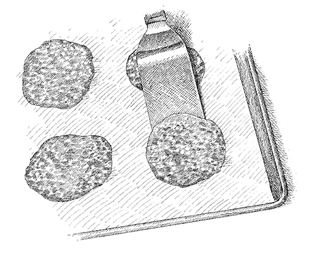
A.
After cooling, slide wide metal spatula under 1 cookie. If it does not bunch or tear, cookies are ready to move.
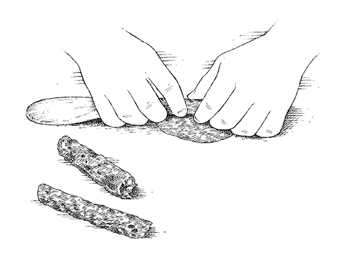
B.
To make “cigarette” place cookie against handle of wooden spoon and roll cookie over itself as quickly as possible.
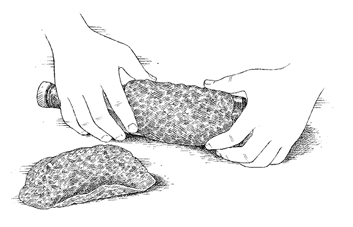
C.
To form tuile, lay cookie over rolling pin or wine bottle set on its side so that cookie forms gentle curve.
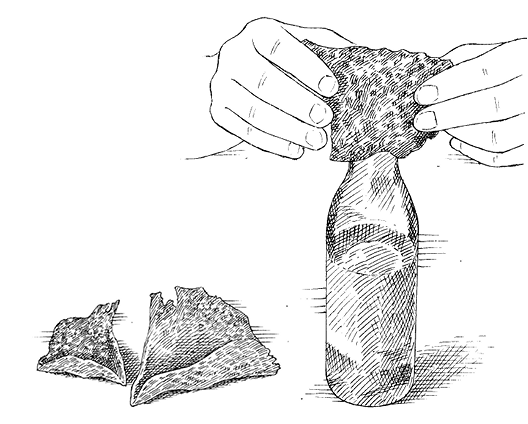
D.
To form tricornered hat, mold cookie over opening of wine bottle or other bottle of similar shape, then flute edges to form tricornered hat shape. Hold until set.
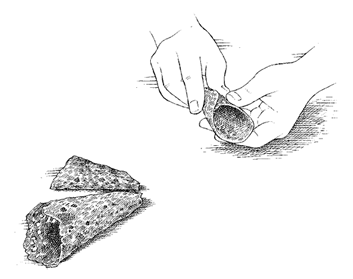
E.
Cones are easiest shaped by hand. Holding both sides of cookie, wrap 1 side over other, overlapping about 1 inch or so.
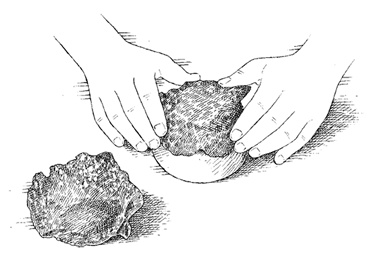
F.
To form bowl, lay cookie over bottom of small bowl turned upside down and gently mold cookie to follow contour of bowl.
